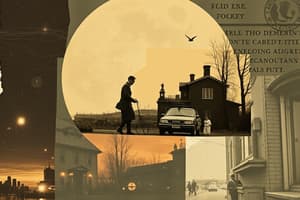Podcast
Questions and Answers
Which of the following elements is NOT part of the plot structure?
Which of the following elements is NOT part of the plot structure?
- Falling Action
- Exposition
- Character Development (correct)
- Climax
In the context of web domains, what does the '.edu' suffix represent?
In the context of web domains, what does the '.edu' suffix represent?
- Non-profit organizations
- Government agencies
- Educational institutions (correct)
- Commercial entities
Which type of listening focuses primarily on providing emotional support?
Which type of listening focuses primarily on providing emotional support?
- Empathic Listening (correct)
- Critical/Analytical Listening
- Appreciative Listening
- Comprehensive Listening
Which graphical representation is most effective for showing trends over time?
Which graphical representation is most effective for showing trends over time?
What aspect of the CRAAP test assesses the timeliness of information?
What aspect of the CRAAP test assesses the timeliness of information?
Which type of textual aid is best for arranging information into columns and rows?
Which type of textual aid is best for arranging information into columns and rows?
Which component is typically found in the resolution of a plot?
Which component is typically found in the resolution of a plot?
What is a physical map primarily used to represent?
What is a physical map primarily used to represent?
Flashcards are hidden until you start studying
Study Notes
Short Story Elements
- Characters: Central figures that drive the narrative, may include protagonists and antagonists.
- Setting: Time and place where the story unfolds, impacting tone and mood.
- Plot: Sequence of events that constitutes the story.
- Symbolism: Use of symbols to represent ideas and themes beyond the literal sense.
- Theme: Underlying message or central idea that the narrative conveys.
Plot Structure
- Exposition: Introduces background information, characters, and initial setting.
- Rising Action: Series of events that create suspense and develop conflict.
- Climax: The turning point or most intense moment in the story.
- Falling Action: Events that occur after the climax leading towards resolution.
- Resolution/Denouement: Conclusion of the story where conflicts are resolved.
Domains
- .com: Commercial websites primarily for businesses.
- .org: Non-profit organizations, often advocacy or service-oriented.
- .gov: Official websites of government agencies.
- .edu: Educational institutions, providing academic resources.
- .net: Network organizations, often related to internet services.
Textual Aid Types
- Titles & Sub-titles: Give insight into the content, highlighting main ideas.
- Illustration: Provides visual representation to enhance understanding.
- Tables: Organize information into clear rows and columns for quick reference.
- Graphs: Visualize data relationships; types include:
- Bar Graph: Compares quantities across different categories.
- Line Graph: Best for displaying trends over time.
- Pie Chart: Shows proportions of a whole.
- Pictograph: Uses images to represent data visually.
- Maps: Display geographical or political features:
- Physical Map: Shows natural features like mountains or rivers.
- Political Map: Indicates boundaries, cities, and other human-made features.
Types of Listener/Listening
- Appreciative Listening: Done for pleasure and enjoyment of the content.
- Empathic Listening: Aimed at providing emotional support and understanding.
- Comprehensive Listening: Focuses on understanding and absorbing the message.
- Critical/Analytical Listening: Evaluates the logic and reasonableness of the message.
CRAAP Criteria
- Currency: Evaluates the timeliness of the information.
- Relevance: Assesses how well the information meets the user’s needs.
- Authority: Examines the credibility of the source.
- Accuracy: Determines the reliability and correctness of the information.
- Purpose: Analyzes the reason the information was created.
Studying That Suits You
Use AI to generate personalized quizzes and flashcards to suit your learning preferences.




